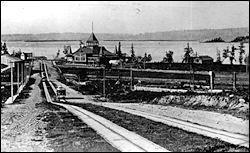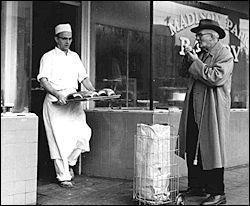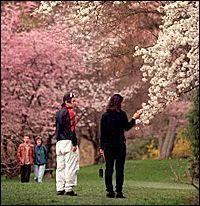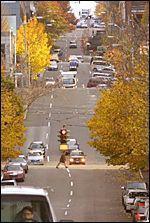 |
COURTESY OF THE MUSEUM OF HISTORY AND INDUSTRY

|
| The Madison Street Cable Railway transported Seattle residents to amusement-park attractions in Madison Park. This view of Madison Street from near its present intersection with East Galer Street highlights the Madison Park Pavilion, a venue for dances, concerts and shows. |
1. Madison Park
Judge John McGilvra and his family had the first homestead in what is now Madison Park — more than 400 acres along Lake Washington — and in 1864, he built Madison Street linking his land and what is now downtown Seattle. Sixteen years later, he turned 24 of his acres into a public park and leased other parts of his property for the building of cottages. He ran a daily stagecoach the length of Madison, and soon the area became a favorite getaway for Seattle residents, who came to rent canoes, listen to John Philip Sousa marches playing on twin bandstands and walk along a promenade. Cable cars began running along Madison Street in 1890, and cross-lake ferry service began later in the decade, making the area even more popular. With the construction of the Lake Washington Ship Canal, which opened in 1917, the lake's water level dropped 9 feet, exposing a pristine shoreline for the by-then-kitschy resort.
Today, Madison Park is one of Seattle's trendiest neighborhoods with more than 4,000 residents and a mix of shops, restaurants, waterfront condos and houses.
 |
SEATTLE TIMES FILES

|
| A baker brings out day-old bread at the Madison Park Bakery in 1958. |
|
In 1880, McGilvra, U.S. Attorney for Washington Territory, turned 24 of his more than 400 acres into a public park and leased other parts of his property for the building of cottages in what is now Madison Park. He ran a daily stagecoach the length of Madison Street, and soon the area became a favorite getaway for Seattle residents, who came to rent canoes, listen to John Philip Sousa marches playing on twin bandstands and walk along a promenade. Cable cars began running along Madison Street in 1890, and cross-lake ferry service began later in the decade, making the area even more popular. With the construction of the Lake Washington Ship Canal, which opened in 1917, the lake's water level dropped 9 feet, exposing a pristine shoreline for the by-then-kitschy resort.
Today, Madison Park is one of Seattle's trendiest neighborhoods with more than 4,000 residents and a mix of shops, restaurants, waterfront condos and houses.
2. Broadmoor
Intended to be "the country club within the city" when it opened in 1927, the 216-acre gated community was built to give the city's wealthy a place to live in seclusion. But with fortunes lost during the Depression, it wasn't until after World War II that Broadmoor became an exclusive enclave for the wealthy.
Today, Broadmoor continues to be an exclusive community, with guards posted at gates and an 18-hole golf course that often hosts tournaments.
 |
STEVEN RINGMAN / THE SEATTLE TIMES, 1997

|
| Strolling the Washington Park Arboretum's Azalea Way, a couple stop to admire flowering cherry trees. |
3. Washington Park Arboretum
A deal in 1934 between the University of Washington and the city gave birth to the Arboretum. The city set aside 260 acres, while the UW established a botanical garden and park that featured Northwest trees and shrubs. Most of the Arboretum's features, such as the Stone Cottage and the Azalea Way trail, were built by 800 Works Progress Administration laborers starting in 1936.
Today, the Arboretum draws more than 250,000 visitors a year to see more than 30,000 native trees and shrubs, and 10,000 nonnative species.
4. Madison Valley
William Grose, a hotel and restaurant owner and Seattle's second African-American resident, was the first to settle what is known today as Madison Valley. He bought 12 acres from Henry Yesler for $1,000 in 1882 and moved his family there eight years later. Other African Americans soon followed, and black-owned stores and restaurants flourished. Housing covenants that excluded minorities coupled with a boom in war industries during World War II led other African Americans to the neighborhood, but many of the residents — African American and white — left for the suburbs at the war's end. By 1980, fewer people lived in the area than at any time since the Depression, and Madison Valley, the Central Area and other bordering neighborhoods had the highest percentage of poor people. But a decade of rising property values across the city has brought renewed interest in the area.
Today, Madison Valley is home to the nation's first AIDS hospice, the Bailey-Boushay House, and has a charming shopping district with upscale restaurants and consignment boutiques.
 |
TERESA TAMURA/ THE SEATTLE TIMES, 1996

|
| A member of the Mount Zion Baptist Church Junior Choir waits to sing during the Dr. Martin Luther King Jr. birthday celebration in 1996. The Central Area church serves the largest African-American congregation in the state. |
5. Central Area
The Central Area was largely a Jewish neighborhood until World War I, when many Jews moved to Seward Park and the suburbs, and growing numbers of African Americans moved in. In 1920, residents built Mount Zion Baptist Church along Madison Street to serve the state's largest African-American congregation. In 1968, 10,000 people marched on Madison Street in memory of Dr. Martin Luther King Jr., who was assassinated in April of that year. But the composition of the Central Area has changed in the past decade. While African Americans made up about 51 percent of the population in 1990, by last year, that percentage had fallen to 32 percent. New construction has rejuvenated the neighborhood since it was one of the city's poorest in 1980, but the business district along several blocks of Madison Street has changed little.
Today, empty beer cans litter the sidewalks and loiterers hang out in front of the strip's several bars. Area residents regularly walk the block en masse with signs condemning drug dealing.
 |
SEATTLE TIMES FILES

|
| Students outside the William Pigott building for Commerce and education pause to compare notes on the first day of class in 1971 at Seattle University. |
|
6. Seattle University
The Rocky Mountain Mission of the Society of Jesus bought land at the intersection of Broadway and Madison from Arthur Denny for $18,382 in 1890, to open the Immaculate Conception parish and school in 1894, which became Seattle College in 1898 and Seattle University in 1948. In 1899, 137 boys each paid $15 a year tuition.
Today, more than 6,000 students attend the university, paying annual tuition of about $18,000.
7. First Hill
First Hill was the residence of choice in the 1890s for elite Seattle residents who wanted to escape the fast pace of downtown. Famous Seattleites such as Judge Cornelius Hanford, meatpacker Charles Frye, and contractors Morgan Carkeek and Otto Ranke built homes along Madison Street. But the 40-odd mansions gave way to more middle-class residents after the Madison Street cable car began regular runs through the area and barbershops and candy stores soon sprang up. The area's first hospital, Swedish Hospital, opened in 1908.
Today, six hospitals on First Hill have caused it to be nicknamed "Pill Hill." The Sorrento Hotel, built in 1908, and the Martin Van Buren Stacy Mansion, which became the home of the exclusive University Club in 1901, continue to attest to First Hill's swanky past.
8. Seattle Central Library
The first library on the site opened in 1906. Funded by Andrew Carnegie, it served almost 30,000 borrowers that year. It was torn down in 1957, after being damaged in the 1949 earthquake, and a $4.5 million library opened on the site in 1960. The new library was one of the first downtown buildings where women could wear pants to work.
Today, the site is a fenced-off construction zone. The collections have been moved to a temporary location at the Washington State Convention and Trade Center until a $160 million library opens at the old site in 2003.
 |
MIKE SIEGEL / THE SEATTLE TIMES

|
| The view looking east up Madison Street from the Seattle Fire Department's Station 5 on Alaskan Way. |
9. Federal Office Building
In 1889, the Great Seattle Fire, which decimated 30 city blocks, began in the basement of a cabinet shop at First Avenue and Madison when glue heating on a stove boiled over and caught fire. In 1931, the Federal Office Building was constructed where the old cabinet shop had once stood, housing 40 government agencies handling everything from alcohol prohibition to veterans' issues.
Today, about 600 people working for 12 agencies are housed in the building and along an outside wall is a plaque commemorating the fire's starting place.
10. Seattle Fire Department's Station 5
At the west foot of Madison, on Alaskan Way, with nine firefighters, a fireboat and a small hose wagon, Station 5 was inaugurated in 1891. After two more renditions were constructed and torn down, a fourth station opened in 1963.
Today, that station, highlighted by red neon accents, houses eight firefighters, one fire engine and two fireboats -- the Chief Seattle and the reserve 1927 Alki.
Sources included Paul Dorpat's "Seattle Now & Then" series, the Historic Seattle Preservation and Development Authority, HistoryLink, the Museum of History & Industry and the book "Seattle Fire Department Centennial Commemorative." Seattle Times staff researcher Justin Mayo contributed to this report.
Gina Kim can be reached at 206-464-2761 or gkim@seattletimes.com.
|
 Monday, November 12, 2001 - 12:00 a.m. Pacific
Monday, November 12, 2001 - 12:00 a.m. Pacific




